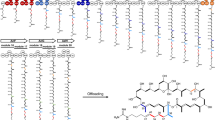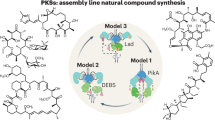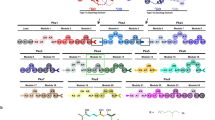Abstract
Modular polyketide synthases are giant multifunctional enzymes that catalyse the condensation of small carboxylic acids such as acetate and propionate into structurally diverse polyketides that possess a spectrum of biological activities1,2. In a modular polyketide synthase, an enzymatic domain catalyses a specific reaction, and three to six enzymatic domains involved in a condensation-processing cycle are organized into a module3. A fundamental aspect of a modular polyketide synthase is that its module arrangement linearly specifies the structure of its polyketide product3. Here we report a natural example in which alternative expression of the pikromycin polyketide synthase results in the generation of two macrolactone structures. Expression of the full-length modular polyketide synthase PikAIV in Streptomyces venezuelae generates the 14-membered ring macrolactone narbonolide, whereas expression of the amino-terminal truncated form of PikAIV leads to ‘skipping’ of the final condensation cycle in polyketide biosynthesis to generate the 12-membered ring macrolactone 10-deoxymethynolide. Our findings provide insight into the structure and function of modular polyketide synthases, as well as a new set of tools to generate structural diversity in polyketide natural products.
This is a preview of subscription content, access via your institution
Access options
Subscribe to this journal
Receive 51 print issues and online access
$199.00 per year
only $3.90 per issue
Buy this article
- Purchase on Springer Link
- Instant access to full article PDF
Prices may be subject to local taxes which are calculated during checkout




Similar content being viewed by others
References
Hopwood, D. A. & Sherman, D. H. Molecular genetics of polyketides and its comparison to fatty acid biosynthesis. Annu. Rev. Genet. 24, 37–66 (1990).
Cane, D. E., Walsh, C. T. & Khosla, C. Harnessing the biosynthetic code: combinations, permutations, and mutations. Science 282, 63–68 (1998).
Donadio, S., Staver, M. J., McAlpine, J. B., Swanson, S. J. & Katz, L. Modular organization of genes required for complex polyketide biosynthesis. Science 252, 675–679 (1991).
Cortes, J., Haydock, S. F., Roberts, G. A., Bevitt, D. J. & Leadlay, P. F. An unusually large multifunctional polypeptide in the erythromycin-producing polyketide synthase of Saccharopolyspora erythraea. Nature 348, 176–178 (1990).
Lambalot, R. H. & Cane, D. E. Isolation and characterization of 10-deoxymethynolide produced by Streptomyces venezuelae. J. Antibiot. 45, 1981–1982 (1992).
Hori, T., Maezawa, I., Nagahama, N. & Suzuki, M. Isolation and structure of narbonolide, narbomycin aglycone, from Streptomyces venezuelae and its biological transformation into picromycin via narbomycin. J. Chem. Soc. Chem. Commun. 304–305 (1971).
Sherman, D. H. et al. in Proceedings of the 8th International Biotechnology Symposium Vol. 1 123–137 (Societe Francaise de Microbiologie, Paris, 1988).
Tang, L., Fu, H., Betlach, M. C. & McDaniel, R. Elucidating the mechanism of chain termination switching in the picromycin/methymycin polyketide synthase. Chem. Biol. 6, 553–558 (1999).
Xue, Y., Zhao, L., H. W. & Sherman, D. H. A gene cluster for macrolide antibiotic biosynthesis in Streptomyces venezuelae: architecture of metabolic diversity. Proc. Natl Acad. Sci. USA 95, 12111–12116 (1998).
Staunton, J. et al. Evidence for a double-helical structure for modular polyketide synthases. Nature Struct. Biol. 3, 188–192 (1996).
Gokhale, R. S., Hunziker, D., Cane, D. E. & Khosla, C. Mechanism and specificity of the terminal thioesterase domain from the erythromycin polyketide synthase. Chem. Biol. 6, 117–125 (1999).
Gokhale, R. S., Tsuji, S. Y., Cane, D. E. & Khosla, C. Dissecting and exploiting intermodular communication in polyketide synthases. Science 284, 482–485 (1999).
Rangaswamy, V., Mitchell, R., Ullrich, M. & Bender, C. Analysis of genes involved in biosynthesis of coronafacic acid, the polyketide component of the phytotoxin coronatine. J. Bacteriol. 180, 3330–3338 (1998).
Butler, A. R., Bate, N. & Cundliffe, E. Impact of thioesterase activity on tylosin biosynthesis in Streptomyces fradiae. Chem. Biol. 6, 287–292 (1999).
Schneider, A. & Marahiel, M. A. Genetic evidence for a role of thioesterase domains, integrated in or associated with peptide synthetases, in non-ribosomal peptide biosynthesis in Bacillus subtilis. Arch. Microbiol. 169, 404–410 (1998).
Cortes, J. et al. Repositioning of a domain in a modular polyketide synthase to promote specific chain cleavage. Science 268, 1487–1489 (1995).
Kao, C. M., Luo, G. L., Katz, L., Cane, D. E. & Khosla, C. Manipulation of macrolide ring size by directed mutagenesis of a modular polyketide synthase. J. Am. Chem. Soc. 117, 9105–9106 (1995).
Sambrook, J., Fritsch, E. F. & Maniatis, T. Molecular Cloning: A Laboratory Manual (Cold Spring Harbor Laboratory Press, Cold Spring Harbor, 1989).
Lydiate, D. J., Malpartida, F. & Hopwood, D. A. The Streptomyces plasmid SCP2*: its functional analysis and development into useful cloning vectors. Gene 35, 223–235 (1985).
Bisang, C. et al. A chain initiation factor common to both modular and aromatic polyketide synthases. Nature 401, 502–505 (1999).
Xue, Y., Wilson, D., Zhao, L., Liu, H.-w. & Sherman, D. H. Hydroxylation of macrolactones YC-17 and narbomycin is mediated by the pikC-encoded cytochrome P450 in Streptomyces venezuelae. Chem. Biol. 5, 661–667 (1998).
Acknowledgements
We thank H.-w. Liu, K. A. Reynolds and G. M. Dunny for comments on the manuscript, and X. He for expert technical assistance. This research was supported by the NIH and a grant from the Office of Naval Research (to D.H.S.).
Author information
Authors and Affiliations
Corresponding author
Rights and permissions
About this article
Cite this article
Xue, Y., Sherman, D. Alternative modular polyketide synthase expression controls macrolactone structure. Nature 403, 571–575 (2000). https://doi.org/10.1038/35000624
Received:
Accepted:
Issue Date:
DOI: https://doi.org/10.1038/35000624
This article is cited by
-
Unnatural activities and mechanistic insights of cytochrome P450 PikC gained from site-specific mutagenesis by non-canonical amino acids
Nature Communications (2023)
-
Depsipeptide Intermediates Interrogate Proposed Biosynthesis of Cereulide, the Emetic Toxin of Bacillus cereus
Scientific Reports (2015)
-
Developing Streptomyces venezuelae as a cell factory for the production of small molecules used in drug discovery
Archives of Pharmacal Research (2015)
-
Reconstruction of the saframycin core scaffold defines dual Pictet-Spengler mechanisms
Nature Chemical Biology (2010)
-
Structural basis for macrolactonization by the pikromycin thioesterase
Nature Chemical Biology (2006)
Comments
By submitting a comment you agree to abide by our Terms and Community Guidelines. If you find something abusive or that does not comply with our terms or guidelines please flag it as inappropriate.



